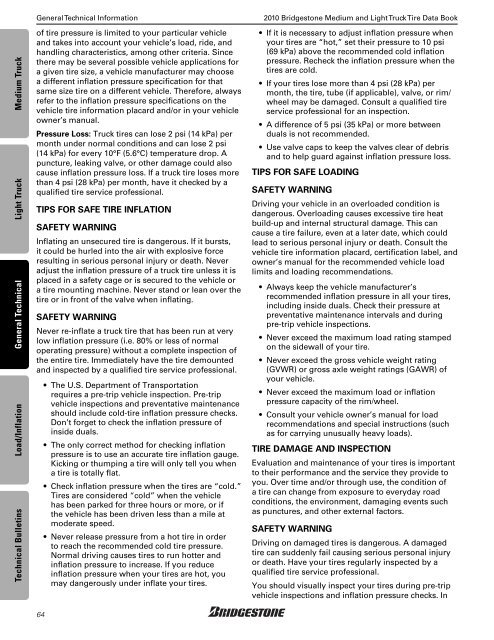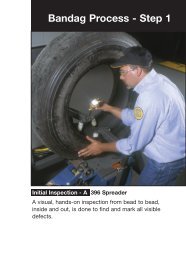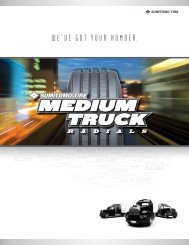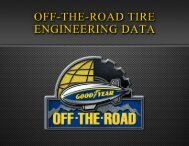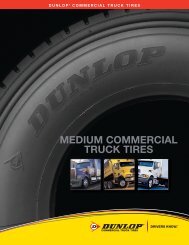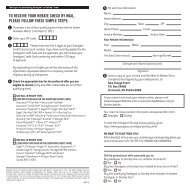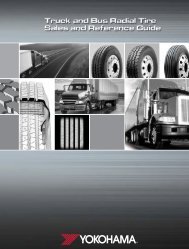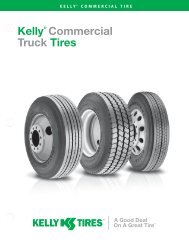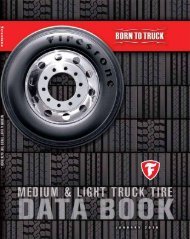Bridgestone Medium and Light Truck Tire Data Book - Sullivan Tire ...
Bridgestone Medium and Light Truck Tire Data Book - Sullivan Tire ...
Bridgestone Medium and Light Truck Tire Data Book - Sullivan Tire ...
You also want an ePaper? Increase the reach of your titles
YUMPU automatically turns print PDFs into web optimized ePapers that Google loves.
Technical Bulletins Load/Inflation General Technical <strong>Light</strong> <strong>Truck</strong> <strong>Medium</strong> <strong>Truck</strong><br />
General Technical Information<br />
of tire pressure is limited to your particular vehicle<br />
<strong>and</strong> takes into account your vehicle’s load, ride, <strong>and</strong><br />
h<strong>and</strong>ling characteristics, among other criteria. Since<br />
there may be several possible vehicle applications for<br />
a given tire size, a vehicle manufacturer may choose<br />
a different inflation pressure specification for that<br />
same size tire on a different vehicle. Therefore, always<br />
refer to the inflation pressure specifications on the<br />
vehicle tire information placard <strong>and</strong>/or in your vehicle<br />
owner’s manual.<br />
Pressure Loss: <strong>Truck</strong> tires can lose 2 psi (14 kPa) per<br />
month under normal conditions <strong>and</strong> can lose 2 psi<br />
(14 kPa) for every 10°F (5.6°C) temperature drop. A<br />
puncture, leaking valve, or other damage could also<br />
cause inflation pressure loss. If a truck tire loses more<br />
than 4 psi (28 kPa) per month, have it checked by a<br />
qualified tire service professional.<br />
TIPS FOR SAFE TIRE INFLATION<br />
SAFETY WARNING<br />
Inflating an unsecured tire is dangerous. If it bursts,<br />
it could be hurled into the air with explosive force<br />
resulting in serious personal injury or death. Never<br />
adjust the inflation pressure of a truck tire unless it is<br />
placed in a safety cage or is secured to the vehicle or<br />
a tire mounting machine. Never st<strong>and</strong> or lean over the<br />
tire or in front of the valve when inflating.<br />
SAFETY WARNING<br />
Never re-inflate a truck tire that has been run at very<br />
low inflation pressure (i.e. 80% or less of normal<br />
operating pressure) without a complete inspection of<br />
the entire tire. Immediately have the tire demounted<br />
<strong>and</strong> inspected by a qualified tire service professional.<br />
64<br />
• The U.S. Department of Transportation<br />
requires a pre-trip vehicle inspection. Pre-trip<br />
vehicle inspections <strong>and</strong> preventative maintenance<br />
should include cold-tire inflation pressure checks.<br />
Don’t forget to check the inflation pressure of<br />
inside duals.<br />
• The only correct method for checking inflation<br />
pressure is to use an accurate tire inflation gauge.<br />
Kicking or thumping a tire will only tell you when<br />
a tire is totally flat.<br />
• Check inflation pressure when the tires are “cold.”<br />
<strong>Tire</strong>s are considered “cold” when the vehicle<br />
has been parked for three hours or more, or if<br />
the vehicle has been driven less than a mile at<br />
moderate speed.<br />
• Never release pressure from a hot tire in order<br />
to reach the recommended cold tire pressure.<br />
Normal driving causes tires to run hotter <strong>and</strong><br />
inflation pressure to increase. If you reduce<br />
inflation pressure when your tires are hot, you<br />
may dangerously under inflate your tires.<br />
2010 <strong>Bridgestone</strong> <strong>Medium</strong> <strong>and</strong> <strong>Light</strong> <strong>Truck</strong> <strong>Tire</strong> <strong>Data</strong> <strong>Book</strong><br />
• If it is necessary to adjust inflation pressure when<br />
your tires are “hot,” set their pressure to 10 psi<br />
(69 kPa) above the recommended cold inflation<br />
pressure. Recheck the inflation pressure when the<br />
tires are cold.<br />
• If your tires lose more than 4 psi (28 kPa) per<br />
month, the tire, tube (if applicable), valve, or rim/<br />
wheel may be damaged. Consult a qualified tire<br />
service professional for an inspection.<br />
• A difference of 5 psi (35 kPa) or more between<br />
duals is not recommended.<br />
• Use valve caps to keep the valves clear of debris<br />
<strong>and</strong> to help guard against inflation pressure loss.<br />
TIPS FOR SAFE LOADING<br />
SAFETY WARNING<br />
Driving your vehicle in an overloaded condition is<br />
dangerous. Overloading causes excessive tire heat<br />
build-up <strong>and</strong> internal structural damage. This can<br />
cause a tire failure, even at a later date, which could<br />
lead to serious personal injury or death. Consult the<br />
vehicle tire information placard, certification label, <strong>and</strong><br />
owner’s manual for the recommended vehicle load<br />
limits <strong>and</strong> loading recommendations.<br />
• Always keep the vehicle manufacturer’s<br />
recommended inflation pressure in all your tires,<br />
including inside duals. Check their pressure at<br />
preventative maintenance intervals <strong>and</strong> during<br />
pre-trip vehicle inspections.<br />
• Never exceed the maximum load rating stamped<br />
on the sidewall of your tire.<br />
• Never exceed the gross vehicle weight rating<br />
(GVWR) or gross axle weight ratings (GAWR) of<br />
your vehicle.<br />
• Never exceed the maximum load or inflation<br />
pressure capacity of the rim/wheel.<br />
• Consult your vehicle owner’s manual for load<br />
recommendations <strong>and</strong> special instructions (such<br />
as for carrying unusually heavy loads).<br />
TIRE DAMAGE AND INSPECTION<br />
Evaluation <strong>and</strong> maintenance of your tires is important<br />
to their performance <strong>and</strong> the service they provide to<br />
you. Over time <strong>and</strong>/or through use, the condition of<br />
a tire can change from exposure to everyday road<br />
conditions, the environment, damaging events such<br />
as punctures, <strong>and</strong> other external factors.<br />
SAFETY WARNING<br />
Driving on damaged tires is dangerous. A damaged<br />
tire can suddenly fail causing serious personal injury<br />
or death. Have your tires regularly inspected by a<br />
qualified tire service professional.<br />
You should visually inspect your tires during pre-trip<br />
vehicle inspections <strong>and</strong> inflation pressure checks. In


